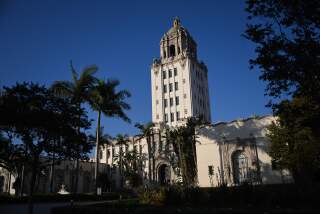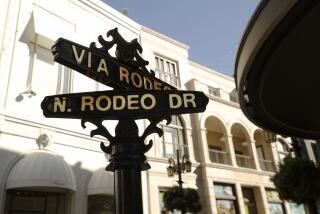Just Where Is Wilshire Boulevard Headed?
- Share via
I enjoyed reading Leon Whiteson’s excellent article regarding the history and development of Wilshire Boulevard (“Boulevard of Dreams,” Aug. 31).
I do, however, take exception to architect Scott Johnson’s misguided comment: “And some of the newer buildings--such as the Wilshire Courtyard complex . . . follow an inappropriate suburban model in their design, detracting from the street’s urban continuity.”
The Courtyard is the single most successful major office development to be constructed along the boulevard in at least a decade.
I would argue that the character of this six-story, 1-million-square-foot development, with its landscaped courts and parks, is quite consistent with the scale and the inviting Southern California character that originally created the spirit of the grand boulevard. It is this spirit that is inherent in the development of the Ambassador Hotel, Bullocks Wilshire, Westlake Park and the old May Co. building.
If blank walls along the sidewalk (such as in the recent addition of the Los Angeles County Museum) or opaque black glass office towers are consistent with Johnson’s definition of “urban continuity,” I suggest we reject this concept as it is this type of development--defensive and uninviting in character--that is part of the problem of the boulevard’s maturation, not its salvation.
CARL F. McLARAND
Costa Mesa
Carl F. McLarand is president of McLarand, Vasquez & Partners Inc., architects of the Wilshire Courtyard.
*
Most critical reports on urban places do not adequately focus on the future, on what places are becoming or what they could be caused to become.
One group has been hard at work for over a decade making plans for a stretch of Wilshire Boulevard. This nonprofit organization named Veterans Park, under the direction of Susan Young, has its focus on the section of Wilshire that Whiteson calls a visual wasteland between Veteran Avenue and San Vicente Boulevard.
A conceptual plan for this half-mile known as Veterans Parkway is nearly completed with the great cooperation of three federal agencies, Los Angeles County, and Caltrans. Support has been provided by many parties, especially the Getty Trust.
This section will become a great civic boulevard, with a new and powerful presence for the magnificent National Cemetery and the freeway interchange converted to a significant entrance to the city.
Let’s celebrate Wilshire Boulevard’s 100th anniversary by planning a future and bringing it into existence.
ROBERT S. HARRIS, Director
Graduate Studies in Architecture
School of Architecture
USC
*
I immensely enjoyed your photo “Wilshire Yesterday.” I beg to differ with you, however, as to the location of the camera shot. Though billed as “Wilshire at Figueroa,” it was actually photographed at the corner of Bonnie Brae Street and Wilshire, a good three-quarters of a mile west of Figueroa.
Incidentally, the rock wall (right front foreground) and steps are still in partial existence on the southeast corner. The Boynton (left front foreground) exists also and is undergoing some sort of restoration at the moment on the northwest corner.
These old photographs are truly absorbing for L.A. history buffs and you are to be commended for publishing them.
WILLIAM D. LONG
Rolling Hills Estates
More to Read
Sign up for Essential California
The most important California stories and recommendations in your inbox every morning.
You may occasionally receive promotional content from the Los Angeles Times.










